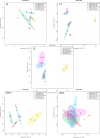Assessing the Impacts of Cu and Mo Engineered Nanomaterials on Crop Plant Growth Using a Targeted Proteomics Approach
- PMID: 38239573
- PMCID: PMC10792604
- DOI: 10.1021/acsagscitech.3c00431
Assessing the Impacts of Cu and Mo Engineered Nanomaterials on Crop Plant Growth Using a Targeted Proteomics Approach
Abstract
In this study, we investigated the effects of molybdenum (Mo)-based nanofertilizer and copper (Cu)-based nanopesticide exposure on wheat through a multifaceted approach, including physiological measurements, metal uptake and translocation analysis, and targeted proteomics analysis. Wheat plants were grown under a 16 h photoperiod (light intensity 150 μmol·m-2·s-1) for 4 weeks at 22 °C and 60% humidity with 6 different treatments, including control, Mo, and Cu exposure through root and leaf. The exposure dose was 6.25 mg of element per plant through either root or leaf. An additional low-dose (0.6 mg Mo/plant) treatment of Mo through root was added after phytotoxicity was observed. Using targeted proteomics approach, 24 proteins involved in 12 metabolomic pathways were quantitated to understand the regulation at the protein level. Mo exposure, particularly through root uptake, induced significant upregulation of 16 proteins associated with 11 metabolic pathways, with the fold change (FC) ranging from 1.28 to 2.81. Notably, a dose-dependent response of Mo exposure through the roots highlighted the delicate balance between nutrient stimulation and toxicity as a high Mo dose led to robust protein upregulation but also resulted in depressed physiological measurements, while a low Mo dose resulted in no depression of physiological measurements but downregulations of proteins, especially in the first leaf (0.23 < FC < 0.68) and stem (0.13 < FC < 0.68) tissues. Conversely, Cu exposure exhibited tissue-specific effects, with pronounced downregulation (18 proteins involved in 11 metabolic pathways) particularly in the first leaf tissues (root exposure: 0.35 < FC < 0.74; leaf exposure: 0.49 < FC < 0.72), which indicated the quick response of plants to Cu-induced stress in the early stage of exposure. By revealing the complexities of plants' response to engineered nanomaterials at both physiological and molecular levels, this study provides insights for optimizing nutrient management practices in crop production and advancing toward sustainable agriculture.
© 2023 The Authors. Published by American Chemical Society.
Conflict of interest statement
The authors declare no competing financial interest.
Figures









Similar articles
-
Integrating Targeted Metabolomics and Targeted Proteomics to Study the Responses of Wheat Plants to Engineered Nanomaterials.ACS Agric Sci Technol. 2024 Apr 2;4(4):507-520. doi: 10.1021/acsagscitech.4c00046. eCollection 2024 Apr 15. ACS Agric Sci Technol. 2024. PMID: 38638683 Free PMC article.
-
Metabolomic Response of Early-Stage Wheat (Triticum aestivum) to Surfactant-Aided Foliar Application of Copper Hydroxide and Molybdenum Trioxide Nanoparticles.Nanomaterials (Basel). 2021 Nov 15;11(11):3073. doi: 10.3390/nano11113073. Nanomaterials (Basel). 2021. PMID: 34835836 Free PMC article.
-
Favorable physiological and morphological effects of molybdenum nanoparticles on tobacco (Nicotiana tabacum L.): root irrigation is superior to foliar spraying.Front Plant Sci. 2023 Aug 31;14:1220109. doi: 10.3389/fpls.2023.1220109. eCollection 2023. Front Plant Sci. 2023. PMID: 37719206 Free PMC article.
-
Effect of Molybdenum on Plant Physiology and Cadmium Uptake and Translocation in Rape (Brassica napus L.) under Different Levels of Cadmium Stress.Int J Environ Res Public Health. 2020 Mar 31;17(7):2355. doi: 10.3390/ijerph17072355. Int J Environ Res Public Health. 2020. PMID: 32244320 Free PMC article.
-
Toxicity, physiological, and morphological alterations of Indian camphorweed (Pluchea indica) in response to excess copper.Environ Geochem Health. 2023 Nov;45(11):7637-7649. doi: 10.1007/s10653-023-01679-5. Epub 2023 Jul 4. Environ Geochem Health. 2023. PMID: 37402936
Cited by
-
Integrating Targeted Metabolomics and Targeted Proteomics to Study the Responses of Wheat Plants to Engineered Nanomaterials.ACS Agric Sci Technol. 2024 Apr 2;4(4):507-520. doi: 10.1021/acsagscitech.4c00046. eCollection 2024 Apr 15. ACS Agric Sci Technol. 2024. PMID: 38638683 Free PMC article.
References
-
- Humbal A.; Pathak B.. Application of Nanotechnology in Plant Growth and Diseases Management: Tool for Sustainable Agriculture. In Agricultural and Environmental Nanotechnology: Novel Technologies and Their Ecological Impact; Fernandez-Luqueno F.; Patra J. K., Eds.; Interdisciplinary Biotechnological Advances; Springer Nature: Singapore, 2023; pp 145–168.
-
- Şahin E. C. ¸.; Aydın Y.; Utkan G.; Uncuoğlu A. A.. Chapter 22 - Nanotechnology in Agriculture for Plant Control and as Biofertilizer. In Synthesis of Bionanomaterials for Biomedical Applications; Ozturk M., Roy A., Bhat R. A., Vardar-Sukan F., Policarpo Tonelli F. M., Eds.; Micro and Nano Technologies; Elsevier, 2023; pp 469–492.
-
- Yadav A.; Yadav K.; Abd-Elsalam K. A. Nanofertilizers: Types, Delivery and Advantages in Agricultural Sustainability. Agrochemicals 2023, 2 (2), 296–336. 10.3390/agrochemicals2020019. - DOI
